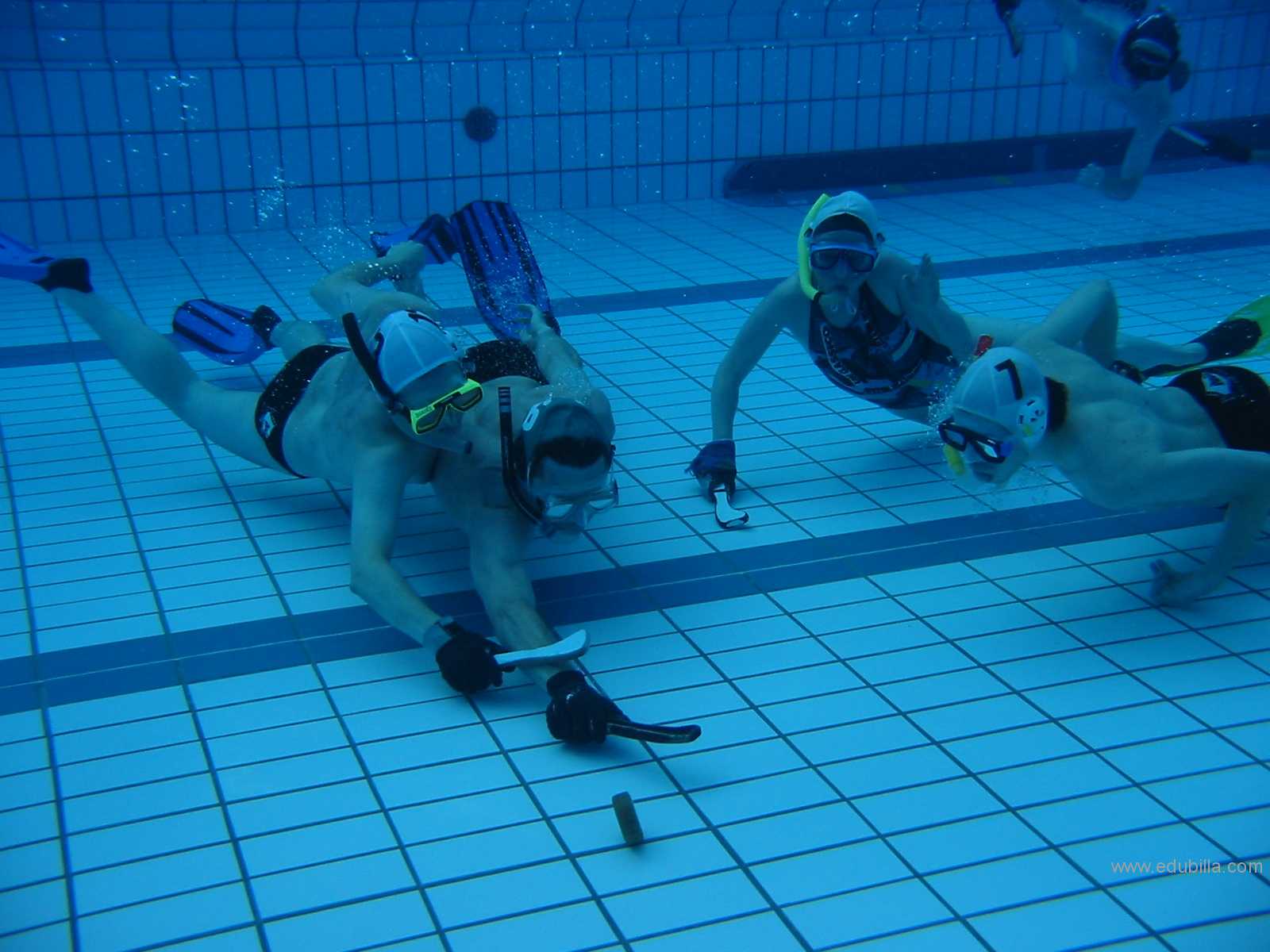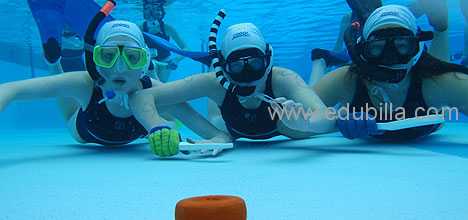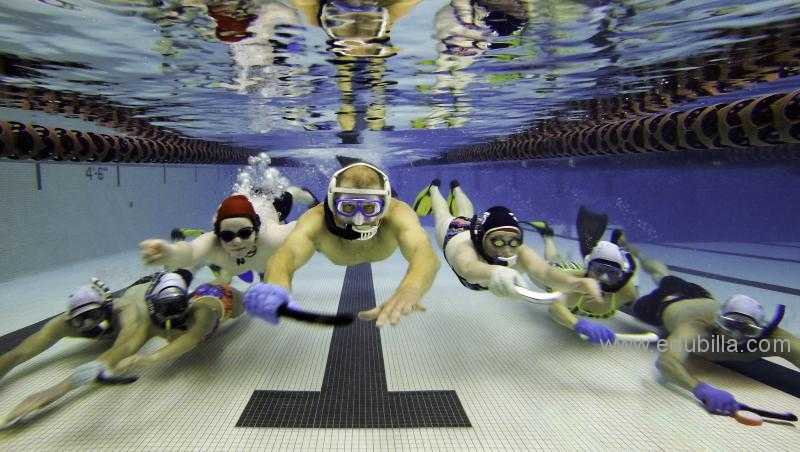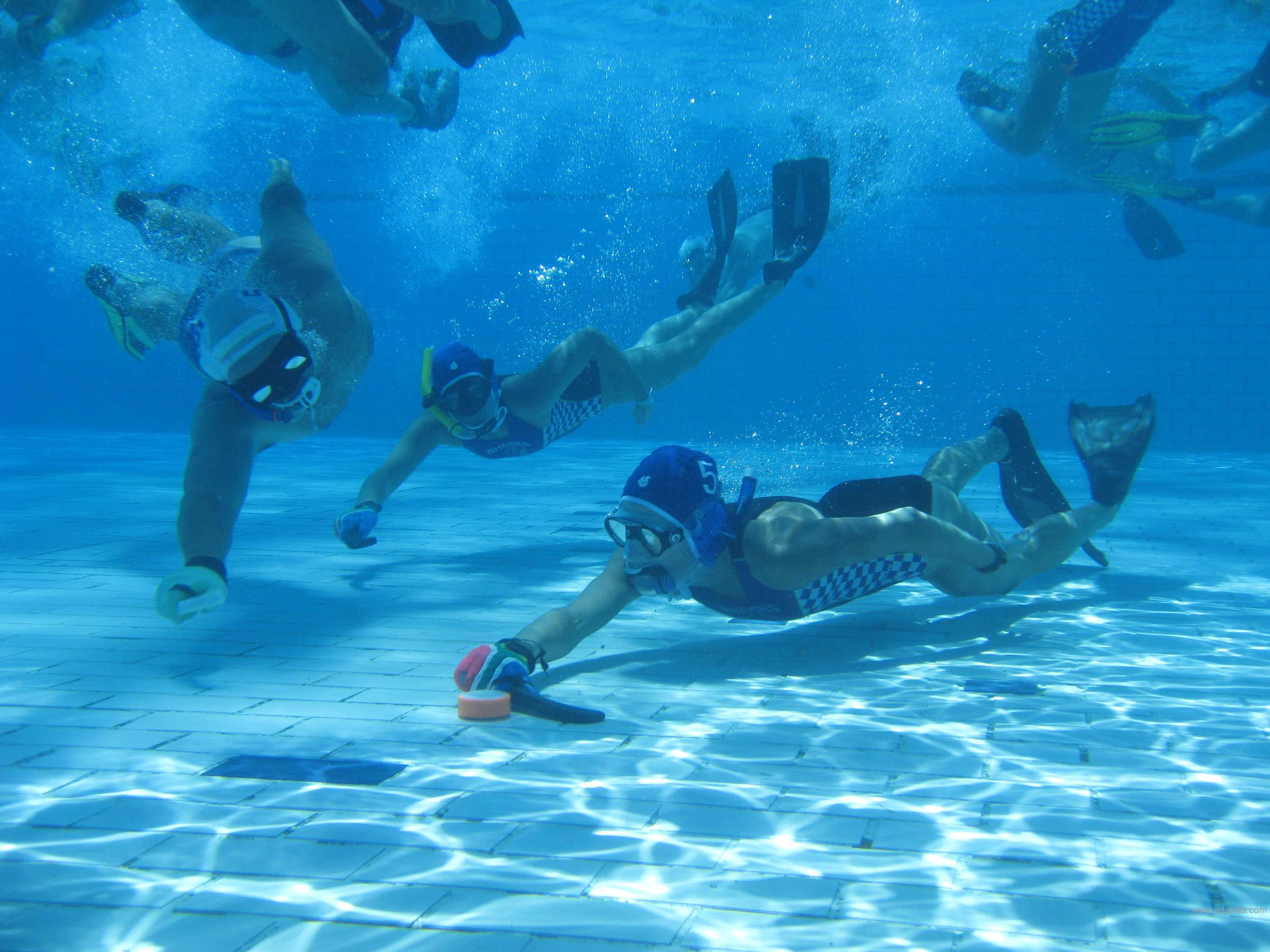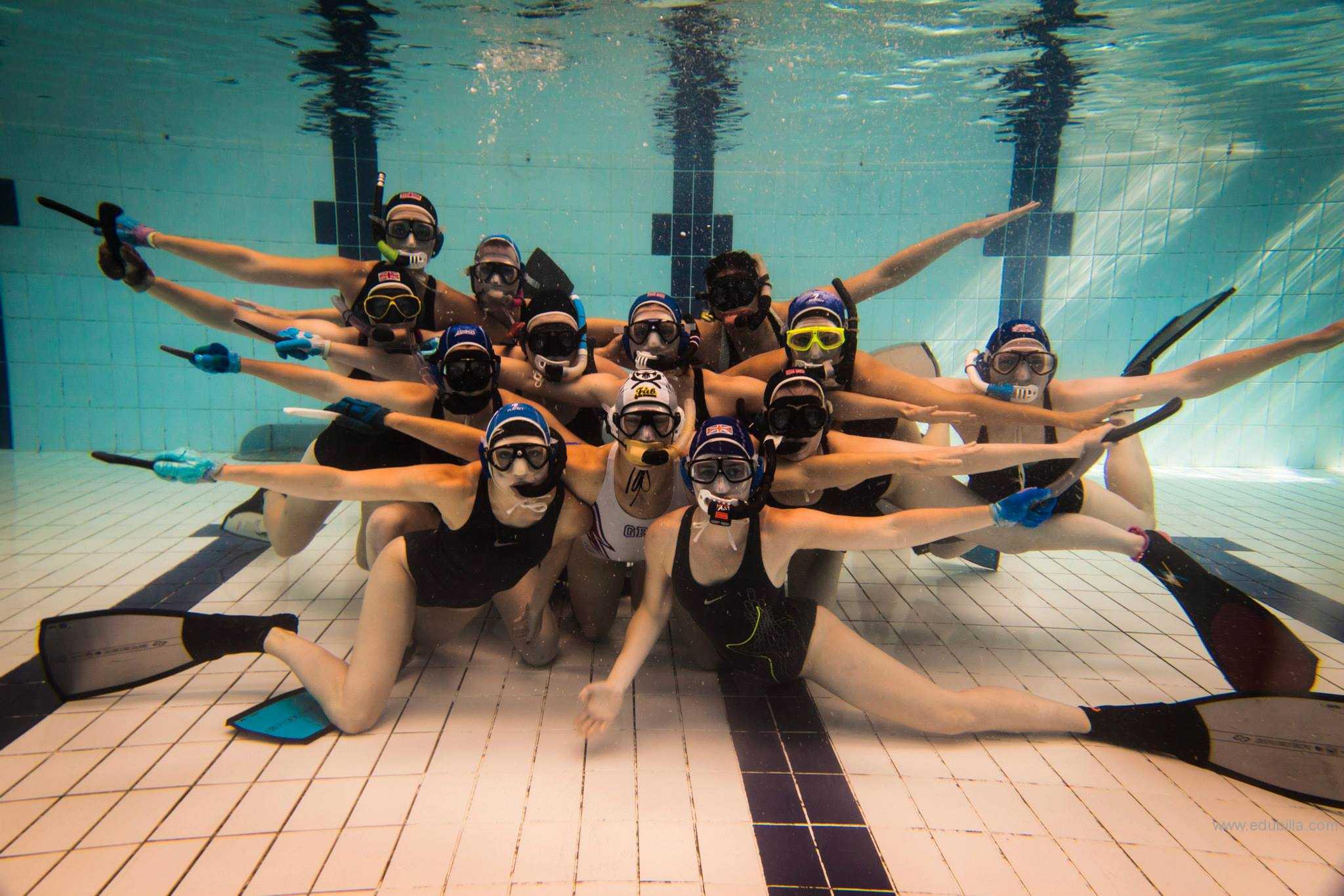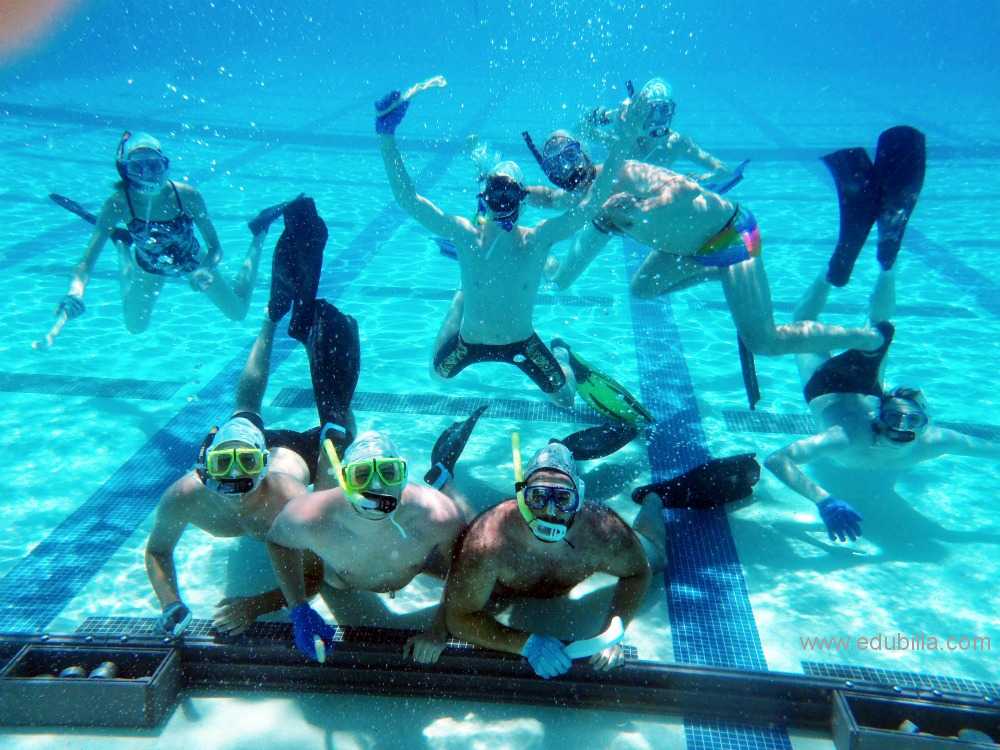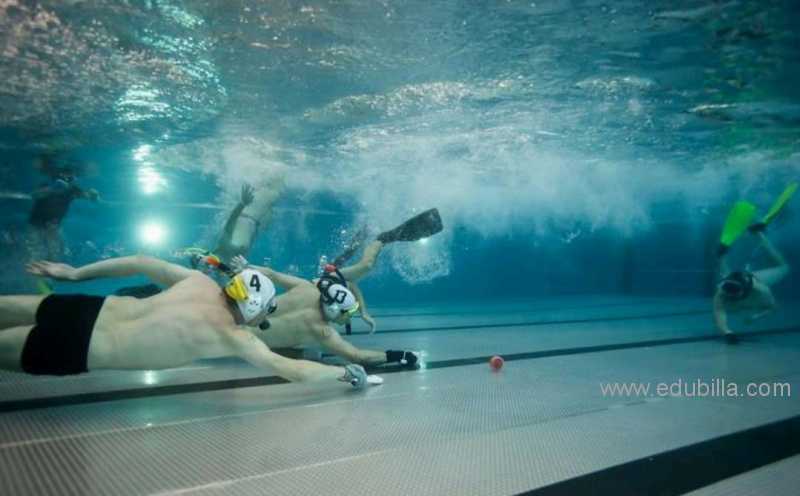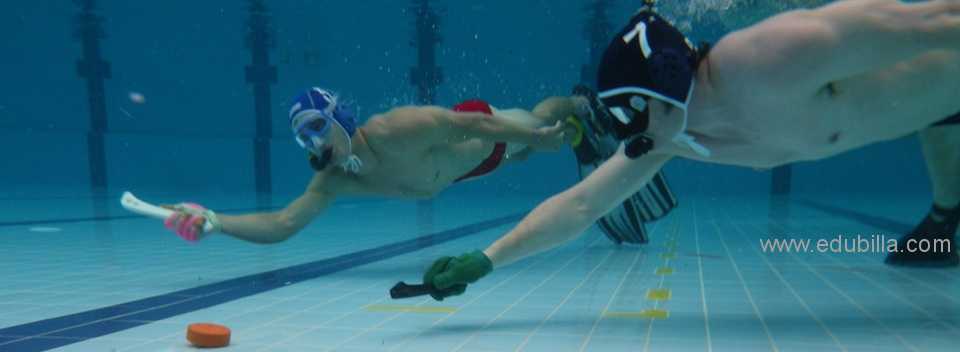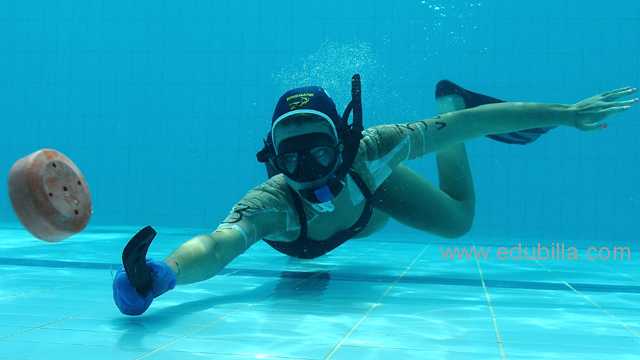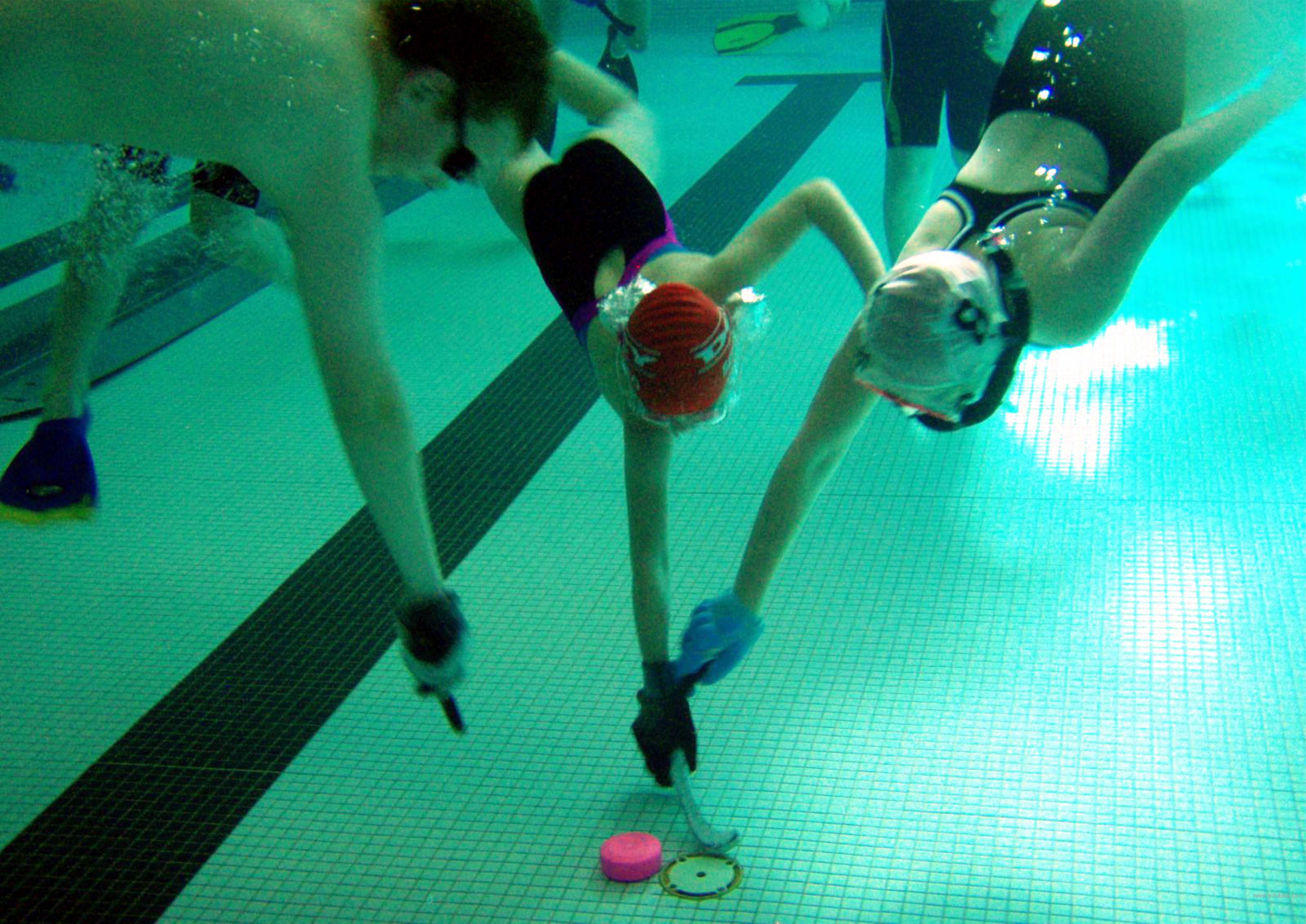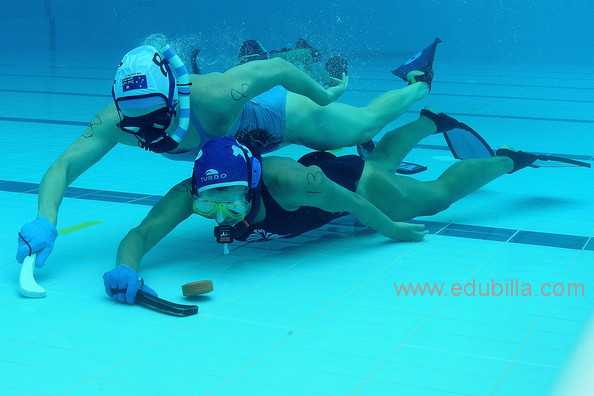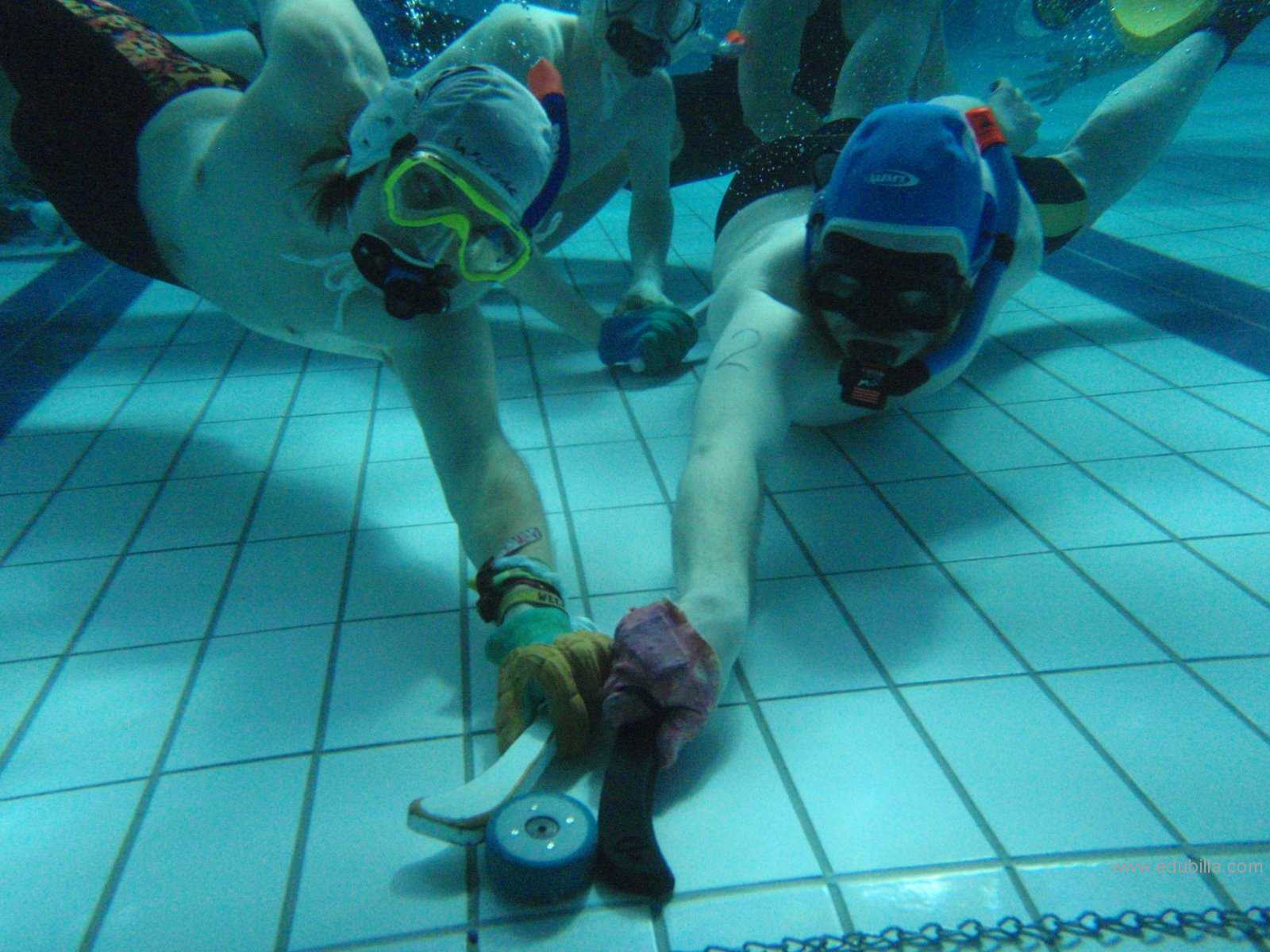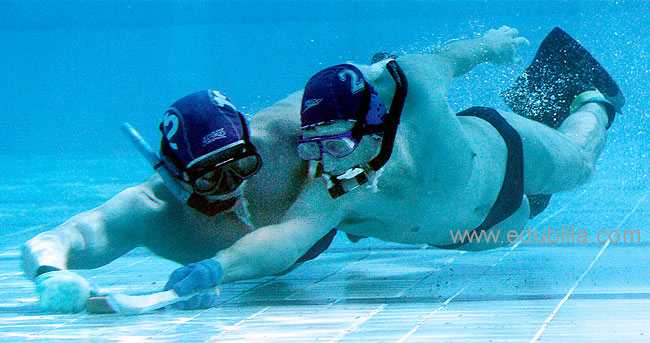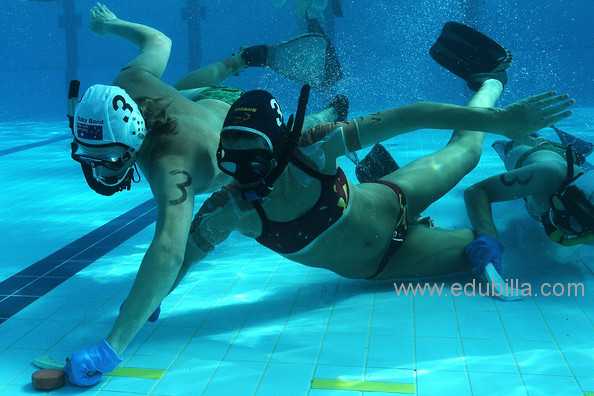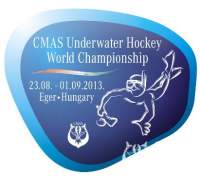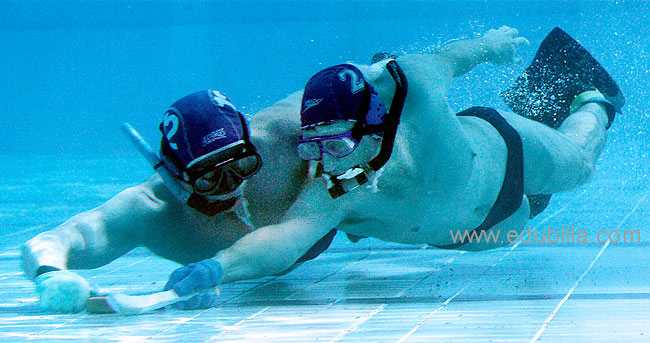
Overview Of Underwater hockey
Underwater Hockey (UWH), (also called Octopush (mainly in the UK)) is a globally played limited-contact sport in which two teams compete to manoeuvre a puck across the bottom of a swimming pool into the opposing team's goal by propelling it with a pusher. It originated in England in 1954 when Alan Blake, the founder of the newly formed Southsea Sub-Aqua Club, invented the game he called Octopush as a means of keeping the club's members interested and active over the cold winter months when open-water diving lost its appeal.Underwater Hockey is now played worldwide, with CMAS as the world governing body.The first Underwater Hockey World Championship was held in Canada in 1980 after a false start in 1979 brought about by international politics and apartheid.
Object Of The Game:
The object of underwater hockey is to successfully hit the puck into your opponent’s goal. The team that scores the most goals in the allotted time is then the winner. Obviously the game is played totally underwater and players must remain underwater until a goal is scored. Only when a break in play for a goal or a foul is called by the referee may players then resurface.
Game Rules
- Teams consist of 10 players with 6 players in the pool at all time. The remaining 4 act as rolling substitutes.
- Games take place for two 15 minute halves with a 5 minute rest period in between halves.
- Players generally cover zones rather than having positions but formations do come into play.
- Teams can also be split into attack and defence. Variations of midfield players have also been noted before.
- Players can only score using the stick in their hands and cannot use any body parts to assist moving the puck. Players are prohibited from making contact with players unless they are in possession of the puck.
Detailed Underwater hockey Rules Can Be Downloaded From Documents
Equipments Need For Underwater hockey
Swimwear:
There are usually no restrictions on swimwear, however baggy style trunks or shorts are not recommended as they reduce speed and increase drag in the water. Typical swimwear is swim briefs for male players and one-piece swimsuits for female players.
Mask:
A diving mask is used for several reasons:
- Players can equalise their ears (using the Valsalva manoeuvre) as the nose is covered
- Unlike swim goggles a mask sits outside the eye's orbit, reducing the effects of any impact on the mask
- Improved underwater visibility
A low-volume mask with minimal protrusion from the face reduces the likelihood of the mask being knocked, causing it to leak or flood and temporarily blind the player. In line with the rules any masks must have two lenses since a single lens mask poses a significant safety hazard in the event that an unfortunately placed puck should hit (and possibly pass through) the lens. A variety of webbing strap designs are available to replace the original head strap with a non-elastic strap that further reduces the chances of the player being de-masked.
Snorkel:
A snorkel enables players to watch the progress of the game without having to remove their head from the water to breathe. This allows them to keep their correct position on the surface, ready to resume play once they have recovered. In order to maximise the efficiency of breathing and reduce drag underwater they are often short and wide bore, with or without a drain valve. They must not be rigid or have any unnecessarily acute edges or points.
The snorkel may accommodate an external mouthguard which may be worn in conjunction with, or instead of, an internal mouthguard.
Fins:
Fins allow the player to swim faster through the water. A wide range of fins are used in the sport but large plastic/rubber composite fins or smaller, stiffer fibre glass or carbon fibre fins are commonplace at competitions. Once again they must have no unnecessarily acute or sharp edges, nor buckles.
Stick:
The stick (also referred to as a 'bat' or 'pusher') is relatively short (according to recent rules, not more than 350mm including the handle) and is coloured white or black to indicate the player's team. The stick may only be held in one hand, which is usually determined by the player's handedness, although players may swap hands during play. The shape of the stick may affect playing style and is often a very personal choice. A wide variety of stick designs are allowed within the constraints of the rules of the game, the principal rules being that the stick must fit into a box of 100x50x350mm and that the stick must not be capable of surrounding the puck or any part of the hand. A rule concerning the minimum radius of edges tries to address the risk that the stick might become more of a weapon than a playing tool. Construction materials may be of wood or plastics and current rules now supersede those that previously required sticks to be homogeneous, although they almost always are anyway. Many players of UWH manufacture their own sticks to their preferred shape and style, although there are increasingly more mass-produced designs to suit the majority (such as Bentfish, Britbat, CanAm, Dorsal, Stingray etc.).
Puck:
The puck is approximately the size of an ice hockey puck but is made of lead or similar material (Adult size weighs 3 lb (1.3-1.5 kg), Junior 1¾ lb (800-850 g)) and is encapsulated or surrounded by a plastic covering which is usually matched to the pool bottom to facilitate good grip on the stick face while preventing excessive friction on the pool bottom. The puck's weight brings it to rest on the pool bottom, though can be lofted during passes.
Hat:
Safety gear includes ear protection, usually in the form of a water polo cap to protect the eardrums and as a secondary indicator of the player's team (coloured black/blue/dark or white/pale as appropriate). Water referees should wear red hats.
Glove:
A glove should be worn on the playing hand to protect against pool-bottom abrasion and, in some designs, for protection against puck impact on knuckles and other vulnerable areas; however, no rigid protection is permitted. Players may choose to wear a protective glove on both hands, either as additional protection from the pool bottom or, for ambidextrous players, to switch the stick between hands mid-play. A glove used in competition must be a contrasting colour to the wearer's stick, but not orange which is reserved for referees' gloves.
Goal:
The goals (or 'gulleys') are three metres wide and are sited at opposite ends of the playing area on the pool bottom. They consist of a shallow slope leading up to a trough into which the puck may be pushed or flicked. Goals are commonly constructed from aluminium, galvanised or stainless steel. This helps to ensure that they are negatively buoyant and are durable in the chlorinated water of swimming pools.
History Of Underwater hockey
Underwater hockey was created by Alan Blake in Southsea, (Portsmouth, UK) and named "octopus". It was first developed as a winter activity for scuba divers to keep fit. The text below was written by Alan Blake, Southsea No 9 Branch of the British Sub-Aqua Club.
At the close of summer 1954 with evening diving curtailed, the prospect of six months confined to a swimming pool was daunting. As Branch Secretary at the time it seemed essential that a competitive game was needed to soak up the winter interlude.
Edmonton History:
The Edmonton Octopushers is the proud result of efforts by Jim and Janet Jones who, along with many local SCUBA divers, dive clubs and shops, started the club around 1983. With a lot of support from UWH clubs in Calgary, Saskatoon, and Vancouver, the taste for serious competition was developed in the “home town” crew. The Octopushers competed in many regional and local tournaments in Western Canada and enjoyed themselves so much that they hosted their first national tournament at the Kinsmen Pool in 1986.
The original rules had two differences that belong to the past era.
1. The restriction of overarm strokes was a direct adherence to the BS-AC pool rules at that time, similarly jumping in from the edge was forbidden. (Many Bath Superintendents opposed diving clubs using their pools for fear of broken glass.)
2. The non-use of snorkels was also to pacify the Bath Superintendent regarding broken masks, but also to avoid being used as a second implement that would have allowed "dribbling" the squid, so altering the intent and character of the game. The use of snorkels came in once Octopush was disciplined.
Competitions were held with our two neighbouring branches Bournmouth and Brighton in the 1954/55 winter. In March 1955 the first invited public demonstration was held at the Portsmouth City Baths in the Southsea BS-AC Gala.
Underwater hockey Timeline:
1954: Underwater hockey was created by Alan Blake in Southsea, (Portsmouth, UK) and named "octopus". It was first developed as a winter activity for scuba divers to keep fit.
1945-55: The first competitions among clubs were held in the 1954/55 winter.
In March 1955: The first invited public demonstration was held at the Portsmouth City Baths in the Southsea BS-AC Gala.The sport spread quickly to South Africa, France, Canada, and Australia and then to the rest of the world.
1960's: The first national club competitions in UK were held during the sixties.
1970's: During the seventies South Africa, USA, Canada, France and Australia had their first national championships.
1979: In Charleroi (Brussels) the first Cup of Europe was held. In the same year, 1979, the first world championship was to be held in London but due to problems with international politics the event had to be cancelled.
1980: Canada hosted the 1st World championship which took place in Vancouver. Only five teams men elite attended : Canada, USA, the Netherlands, Australia and the United Kingdom. The Netherlands won the gold.
1984: The USA hosted the world championship in Chicago. It was the first championship with men and women teams. 8 countries attended: Australia, New Zealand, the Netherlands, France, United Kingdom, Canada, USA and Zimbawe. 8 men teams and 4 women teams. This year the rules were officially published by CMAS and since then the World championships have been biennial.
2013: The 19th World Championship will be held in Eger (Hungary) where more than 15 countries will attend with teams of all categories men and women, u19, u23, elite and master.
Origin Of Underwater hockey
Originally, the game was the brainchild of Alan Blake of Britain. In 1954, he called it “Octopush.” This game was designed to keep scuba divers fit during the non-diving season. It was relatively simple. Each player would wear a mask, fins, and snorkel and carry a short stick with a U-shaped end. The stick was use to push a metal puck, along the bottom of the pool, into an underwater net or trough. It was a glorified game of shuffleboard underwater.
First Canadian Men's Championships:
In 1975, the first Canadian Men's Championships were held and in 1978, the first Canadian Women's Championships took place. Both were held in Vancouver, B.C., as well as the first World Tournament in 1980, now a biannual competition. The first Canadian Mixed Championships were held in 1982 in Montreal. The Canadian Underwater Games Association (CUGA), which governs both underwater hockey and underwater rugby in Canada, was formed in 1985. It was around this time that stick design and methods of playing had evolved to what is seen at present.
Popularity:
Underwater hockey is played in at least 36 countries spread across six continents. In countries like Australia and New Zealand, it's popular — and respected — too. According to Opuszynski, underwater hockey is as widespread in New Zealand high schools as football or baseball are in America. Which is maybe why they destroyed our men's team at the World Championship.
First Rules:
The first rules were tested in a 1954 two-on-two game and an announcement was made in the November 1954 issue of Neptune, the then-official news sheet of the British Sub-Aqua Club. The purpose behind the game was to keep members of Southsea Sub-Aqua Club #9 from abandoning the new club during the winter months when it was too cold to dive in the sea.The first Octopush competition between clubs was a three-way tournament between teams from Southsea, Bournemouth and Brighton in early 1955. Southsea won then, and they are still highly ranked at national level today (they won again in 2009 and 2012).
Underwater hockey in Canada:
In the Americas, the game first came to Canada in 1962 via Norm Leibeck, an unconventional Australian scuba diving instructor and dive shop owner, who introduced the sport to a Vancouver dive club. Ten years later, the Underwater Hockey Association of British Columbia (UHABC) was formed and received support from the BC government.
Underwater hockey in Asia:
In Asia, the game first came to the Philippines in the late 1970s through the scuba diving community that became aware of Octopush.
Governing Bodies
World Underwater Federation:
Confédération Mondiale des Activités Subaquatiques (CMAS) is an international federation that represents underwater activities in underwater sport and underwater sciences, and oversees an international system of recreational snorkel and scuba diver training and recognition. It is also known by its English name, the World Underwater Federation, and its Spanish name, Confederacion Mundial De Actividades Subacuaticas. Its foundation in Monaco during January 1959 makes it one of the world's oldest underwater diving organisations.
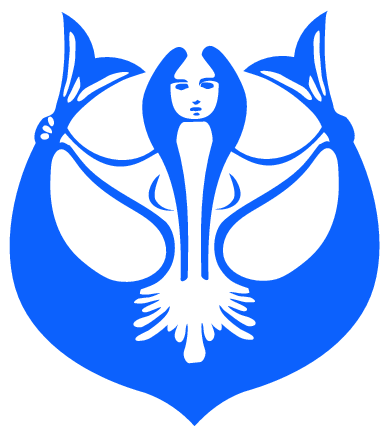
Origins:
An international congress of diving federations representing all underwater disciplines met in Brussels on 28 September 1958. National Delegates attended from following countries: Belgium, Brazil, France, Federal Republic of Germany, Greece, Italy, Monaco, Portugal, Switzerland, the United States of America and the former Yugoslavia. Following a decision at that congress, a meeting was held in Monaco on 9–11 January 1959, which officially established the World Underwater Federation, with an acronym based on its French title as CMAS.
A founding member and key proponent of CMAS was the French underwater explorer and diving pioneer Jacques-Yves Cousteau who was chosen to be the inaugural President with Luigi Ferraro, Italian underwater pioneer, appointed as Vice-President.
CMAS succeeded the Comité des Sports Sous-Marins (Underwater Sports Committee) of the Confédération Internationale de la Pêche Sportive (CIPS) (International Confederation of Sport Fishing), which was founded on 22 February 1952.
Commitees:
Sport Committee:
Everything about underwater sport life.
Technical Committee:
World class standards for all aspects of Scuba Diving.
Scientific Committee:
Marine biology, geology and underwater archeology.
To Visit Click Here.
Awards Related To Underwater hockey
USOC Awards:
In 1989 the Society was admitted to the United States Olympic Committee as an Affiliated Sport. The first opportunity for Olympic competition may come in 2002 in Greece for Fin Swimming. Each year the USOA nominates the MAN AND WOMAN ATHLETE OF THE YEAR AWARD winners to USOC.
USOA athletes are also honored with all sports national champions comprising the ALL AMERICAN DIVE TEAM. Each sport also awards their MAN & WOMAN ATHLETE OF THE YEAR. There are two Sportsmanship Awards: DAN WILKINS MEMORIAL AWARD for U/W Hockey Nationals and the CARL JUDD MEMORIAL AWARD for U/W Hockey Pacific Coast Championships.
The Regional Divers of the Year Award:
Since 1960, the Society has sanctioned four special awards: The NOGI. The award is symbolized by statuettes awarded in four categories: Arts, Sports/Education, Science, Distinguished Service. The NOGI is the ‘Oscar’ of diving and has been awarded to Jacques Cousteau, Sylvia Earl, Glen Engstrom, Valerie Taylor, Paul Tzimoulis, Al Giddings, Stan Waterman and Jack Mc Kenny to name only a few. The Society also recognizes divers at the regional level, The Regional Divers of the Year Award in the categories of Art, Sports, Education, Science & Service.
WA Underwater Hockey Award:
UWH Person of the Year
Best Sportsman
Best Sportswoman
Best U19 Boy and Girl
Most Improved U19 Boy and Girl
Best U15 Boy and Girl
Most Improved U15 Boy and Girl
The British Octopush Association Awards:
Player of the year
Junior player of the year
Sample Documents Of Underwater hockey
-Lance Armstrong

